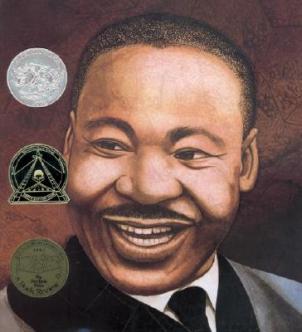Last Monday was the first Martin Luther King Jr. Day where my daughter was old enough to actually ask us about Dr. King and the resulting discussion was awkward, to say the least. The awkwardness began with my daughter’s recounting of what she’d learned about Dr. King in kindergarten, which, of course, was completely jumbled and reprioritized once it passed through her still-developing brain. First, we heard that Dr. King had bombs thrown at his house, then we heard that he got shot (“With a gun, Dad. With a GUN. And he DIED.”), and then we heard, “He just wanted people to love each other.” And those were my daughter’s main talking points about Martin Luther King Jr. – bombs, a gun, and loving each other. It was weird and earnest and cute all at the same time.
We went to a bookstore on MLK Day and my daughter got very excited to see a picture book on Dr. King that her teacher had read in class – Martin’s Big Words: The Life of Dr. Martin Luther King, Jr. by Doreen Rappaport and Bryan Collier. She was so enthusiastic about the book that we bought it for her and spent her bedtime reading and discussing it. Martin’s Big Words is an excellent introduction to the life of Dr. King and the concept of “civil rights” as a whole. My daughter was extremely confused about why white people could make a black person give up their seat on a bus, so we had to try to explain racial inequality to her on the fly and I think it went OK. It’s always hard to tell what she absorbed and what she didn’t, but it was a good discussion to have and Martin’s Big Words was a great facilitator of that discussion.
And Martin’s Big Words doesn’t shy away from things like Dr. King’s assassination, but, to its credit, it does present those details in a very authoritative, non-threatening way for younger readers. I was impressed at how, as a book, it balanced the concerns of its young reading audience with its mission of educating those same kids about the reality of the American civil rights movement. Our kid’s nonfiction collection at home is primarily made up of science books at the moment, so I’m actually really pleased to have such a great work of social history in our home library now.
As I’ve mentioned on this site before, the second that I found out that I was having a daughter, the g-word – GENDER – became a BIG priority for me. I started spending an obnoxious amount of time examining how gender was addressed in every book that came our way, from The Berenstain Bears to Madeline. However, when I look at a book like Martin’s Big Words, I get concerned that – while spending so much energy worrying about gender, steadfastly letting my daughter know that she didn’t need a prince to save her and plying her with books that backed that argument up – our home library may have relatively ignored two other major social concerns that perhaps deserved the same attention. Those two issues in question? Race and class. [read the rest of the post…]
{ 6 comments }
